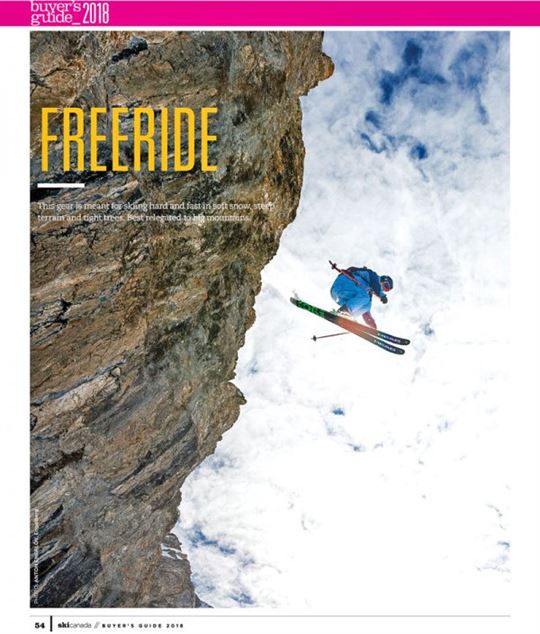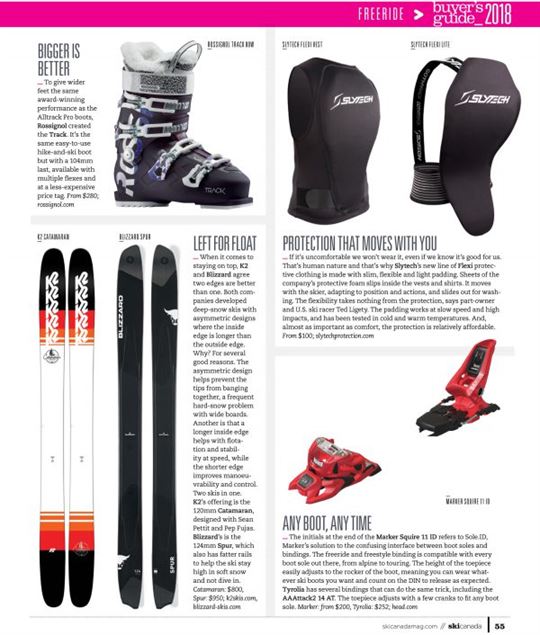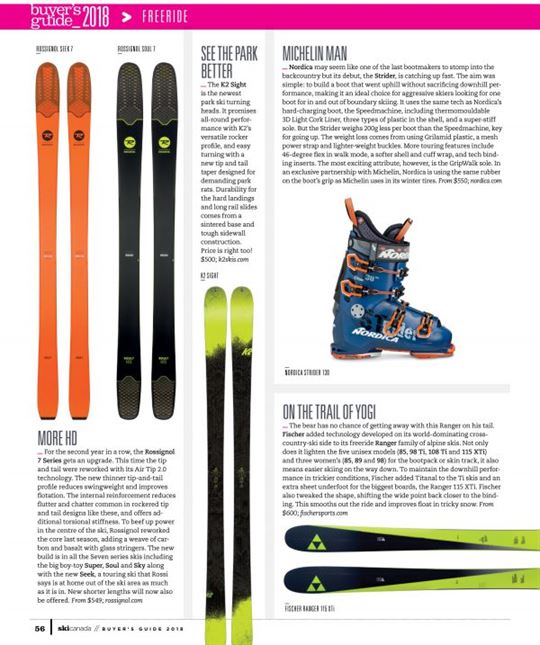This gear is meant for skiing hard and fast in soft snow, steep terrain and tight trees. Best relegated to big mountains.

by RYAN STUART, technical editor in Buyer’s Guide 2018
BIGGER IS BETTER
To give wider feet the same award-winning performance as the Alltrack Pro boots, Rossignol created the Track. It’s the same easy-to-use hike-and-ski boot but with a 104mm last, available with multiple flexes and at a less-expensive price tag. From $280; rossignol.com
LEFT FOR FLOAT
When it comes to staying on top, K2 and Blizzard agree two edges are better than one. Both companies developed deep-snow skis with asymmetric designs where the inside edge is longer than the outside edge. Why? For several good reasons. The asymmetric design helps prevent the tips from banging together, a frequent hard-snow problem with wide boards. Another is that a longer inside edge helps with flotation and stability at speed, while the shorter edge improves manoeuvrability and control. Two skis in one. K2’s offering is the 120mm Catamaran, designed with Sean Pettit and Pep Fujas. Blizzard’s is the 124mm Spur, which also has fatter rails to help the ski stay high in soft snow and not dive in.
Catamaran: $800, Spur: $950; k2skis.com, blizzard-skis.com
PROTECTION THAT MOVES WITH YOU
If it’s uncomfortable we won’t wear it, even if we know it’s good for us. That’s human nature and that’s why Slytech’s new line of Flexi protective clothing is made with slim, flexible and light padding. Sheets of the company’s protective foam slips inside the vests and shirts. It moves with the skier, adapting to position and actions, and slides out for washing. The flexibility takes nothing from the protection, says part-owner and U.S. ski racer Ted Ligety. The padding works at slow speed and high impacts, and has been tested in cold and warm temperatures. And, almost as important as comfort, the protection is relatively affordable. From $100; slytechprotection.com
ANY BOOT, ANY TIME
The initials at the end of the Marker Squire 11 ID refers to Sole.ID, Marker’s solution to the confusing interface between boot soles and bindings. The freeride and freestyle binding is compatible with every boot sole out there, from alpine to touring. The height of the toepiece easily adjusts to the rocker of the boot, meaning you can wear whatever ski boots you want and count on the DIN to release as expected. Tyrolia has several bindings that can do the same trick, including the AAAttack2 14 AT. The toepiece adjusts with a few cranks to fit any boot sole. Marker: from $200, Tyrolia: $252; head.com
SEE THE PARK BETTER
The K2 Sight is the newest park ski turning heads. It promises all-round performance with K2’s versatile rocker profile, and easy turning with a new tip and tail taper designed for demanding park rats. Durability for the hard landings and long rail slides comes from a sintered base and tough sidewall construction. Price is right too! $500; k2skis.com
MICHELIN MAN
Nordica may seem like one of the last bootmakers to stomp into the backcountry but its debut, the Strider, is catching up fast. The aim was simple: to build a boot that went uphill without sacrificing downhill performance, making it an ideal choice for aggressive skiers looking for one boot for in and out of boundary skiing. It uses the same tech as Nordica’s hard-charging boot, the Speedmachine, including thermomouldable 3D Light Cork Liner, three types of plastic in the shell, and a super-stiff sole. But the Strider weighs 200g less per boot than the Speedmachine, key for going up. The weight loss comes from using Grilamid plastic, a mesh power strap and lighter-weight buckles. More touring features include 46-degree flex in walk mode, a softer shell and cuff wrap, and tech binding inserts. The most exciting attribute, however, is the GripWalk sole. In an exclusive partnership with Michelin, Nordica is using the same rubber on the boot’s grip as Michelin uses in its winter tires. From $550; nordica.com
ON THE TRAIL OF YOGI
The bear has no chance of getting away with this Ranger on his tail. Fischer added technology developed on its world-dominating cross-country-ski side to its freeride Ranger family of alpine skis. Not only does it lighten the five unisex models (85, 98 Ti, 108 Ti and 115 XTi) and three women’s (85, 89 and 98) for the bootpack or skin track, it also means easier skiing on the way down. To maintain the downhill performance in trickier conditions, Fischer added Titanal to the Ti skis and an extra sheet underfoot for the biggest boards, the Ranger 115 XTi. Fischer also tweaked the shape, shifting the wide point back closer to the binding. This smooths out the ride and improves float in tricky snow. From $600; fischersports.com
MORE HD
For the second year in a row, the Rossignol 7 Series gets an upgrade. This time the tip and tail were reworked with its Air Tip 2.0 technology. The new thinner tip-and-tail profile reduces swingweight and improves flotation. The internal reinforcement reduces flutter and chatter common in rockered tip and tail designs like these, and offers additional torsional stiffness. To beef up power in the centre of the ski, Rossignol reworked the core last season, adding a weave of carbon and basalt with glass stringers. The new build is in all the Seven series skis including the big boy-toy Super, Soul and Sky along with the new Seek, a touring ski that Rossi says is at home out of the ski area as much as it is in. New shorter lengths will now also be offered. From $549; rossignol.com
BAMBOO IS BETTER
The facts: bamboo boasts the tensile strength of steel, the compressive strength of concrete, absorbs more CO2 than trees and produces more oxygen than any other plant. In other words, it’s an environmentally friendly and durable alternative to carbon or aluminum ski poles. Grass Sticks makes its poles out of whole pieces of bamboo. Its online purchase system includes choosing the colour of the handles, and the size and colour of the baskets. In the end you get a cool-looking, nice-handling set of poles all your own. From US$89; grasssticks.com
FREERIDE LOVE CHILD
A new branch in the Atomic boot family tree just emerged. Linking the all-mountain-slaying Hawk clan and the lightweight backcountry-touring Backland, the Hawk Ultra XTD brings the best of both to one boot. Hawk genes are evident in the heat-mouldable shell and liner, a chassis designed to transfer every foot flinch to the ski, and a multi-density shell that mixes light weight and power. From the Backland comes 54 degrees of fore-aft movement for the skin track, an easy-walking rockered sole, tech-binding inserts, a breathable and washable liner, and 1.4-kg weight per boot. The combination is a versatile boot that charges down and up with equal skill. From $650; atomic.com


